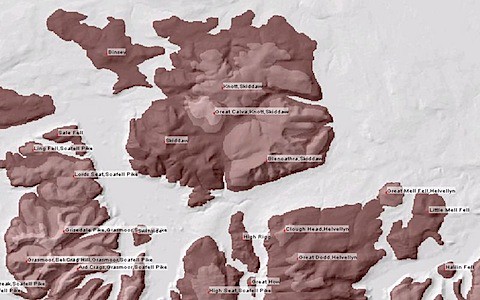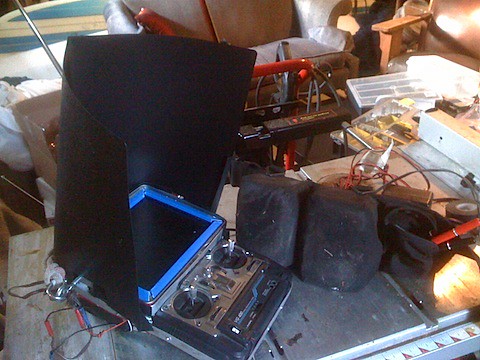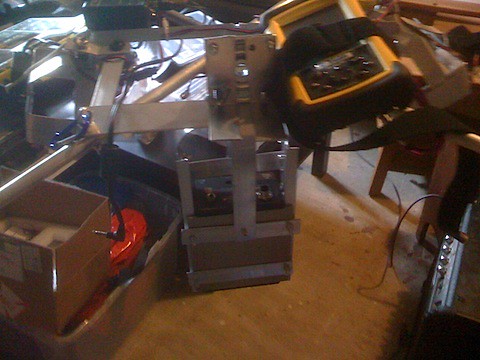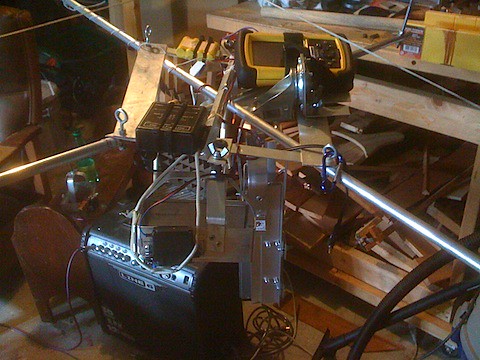An open letter to the Chair of the CLA Faculty Council and the President of the Academic Senate at CSULB.
May 26, 2009
To: Nele Hempel-Lamer, Chair, CLA Faculty Council
Praveen Soni, Chair, Academic Senate
Cc: Gerry Riposa, Dean of Liberal Arts
Brett Mizelle, Chair, EPCC Committee
From: Chrys Rodrigue, Professor, Geography
Chris Lee, Professor, Geography
Carl P. Lipo, Associate Professor, Anthropology
Hector Neff, Professor, Anthropology
RE: Faculty Governance Concerns – EPCC Committee Meeting 19 May 2009
Over the course of the spring 2009 semester a number of Anthropology faculty have organized to remove 16 archaeology-specific Anthropology classes from the archaeology curriculum from the Department. This motion represents a significant programmatic change in the focus and direction of the Anthropology BA/MA degrees, though it was represented as just the minor deletion of a few courses.
On May 19, 2009, the proposal to eliminate all of these courses went to the College EPCC committee and was ultimately "approved". This resolution aside, a number of things took place during the meeting that we find disconcerting with respect to faculty governance and the process by which proposals are evaluated by committees elected by the faculty. Specifically, the faculty governance issues involve the unconventional role of Associate Dean Mark Wiley in the EPCC process and whether his intimidating presence and actions prevented open deliberations and discussions and, therefore, due process for the EPCC to make an informed decision regarding this case. The following points provide some background to our concerns regarding the process undertaken at the May 19th meeting.
(1) Associate Dean Mark Wiley, an ex-officio member, asked to have people removed due to "Fire Marshal" rules. The EPCC meeting is an open meeting and, as such, all interested parties are allowed to attend and participate. Technically speaking, if the number of people in the room surpassed the 15-person seating capacity that the Fire Marshal allows, this should have triggered (a) finding a bigger room or (b) finding another time when everyone could participate. In this sense, Associate Dean Wiley acted to limit the information available to the committee about the nature and impact of the proposal. Ironically, even with the eviction of the students, the room still contained more than 15 faculty, Fire Marshal standards notwithstanding.
(2) Associate Dean Wiley's action removed individuals from the meeting who had no other means of participating in this process of major curriculum change. In Anthropology, lecturers and students are not allowed to attend any meeting (committee or department) and are kept uninformed about proposals that directly impact them. The EPCC meeting is the ONLY place in which they have any voice. Yet, they were prohibited from expressing their voice.
(3) Associate Dean Wiley abused his administrative authority at the meeting, acting at times as de facto Chair and leader of the committee. However, his membership is ex-officio; Dr. Brett Mizelle is the EPCC Chair. The CLA constitution states that, for the EPCC Committee, “The Dean or Dean's designee shall be an ex officio, non-voting member of the Committee. Fundamentally, Associate Dean Mark Wiley, an ex-officio member of the committee, misused his authority as Associate Dean to restrain the process of evaluation and discussion.
(4) The EPCC is a body elected by College Faculty for the purpose of evaluating the potential impact that proposed curriculum changes have on the College as a whole and its mission. By removing interested parties from this meeting, Dean Wiley acted to undermine the democratic basis of the faculty governance process. The practice and the procedures of the committee are neither determined nor decided upon by Associate Dean Wiley. The CLA Constitution (http://www.csulb.edu/colleges/cla/people/constitution.html) states that “The Committee shall act for the College Faculty, in accordance with Policies and Procedures set by the Faculty Council and the University Academic Senate, in all matters involving curriculum and educational programs.”
(5) The disingenuous use of the Course Change proposal mechanism to effect major programmatic restructuring like this should have resulted in the Committee sending the proposal back to the Department with a recommendation that Program Change is the correct procedure, not the Course Change procedure. Had Associate Dean Wiley not intervened improperly to block discussion, the committee could have learned about and considered the magnitude of the course drop proposal and evaluated whether the Course Change procedure was being used to circumvent the fuller discussion required for major programmatic change. Indeed, the Chair of Anthropology testified at the 5/19 meeting that the proposal was, in fact, a program change and not a course change. As such, it should have been evaluated as such a request, a process requiring far greater participation by stakeholders across the campus and involvement by the Faculty Council.
(6) Questions about postponing the vote until adequate information could be obtained were rejected by Associate Dean Wiley (a non-voting ex-officio member, as specified in the CLA Constitution) before they could be evaluated by the Committee. We do not understand his haste: Tabling the vote would not have hurt the proposal, since the same effect could be achieved by the Department simply not running the 16 courses for at least three years. Not tabling the vote did hurt the many stakeholders in the archaeology curriculum (students in archaeology, archaeology faculty, and faculty in other departments and colleges).
(7) It is essential to note that the EPCC committee was not provided with any names or course descriptions for the courses to be eliminated – only course numbers. Additionally, no rationale or justification for the removal of any of them was offered. The Chair of Anthropology failed to provide supporting evidence or a vision of what the degree is supposed to do without the proposed courses. Consequently, there was, effectively, no basis upon which the EPCC committee could have made an informed decision. In this regard, the decision-making process at the May 19th meeting deviated from all other actions on curriculum proposals, in which specific documents and rationale are required and reviewed. The Anthropology course removal proposal was a particularly unusual request for consideration by the EPCC committee in that it represented a major programmatic change in the content and curriculum of the BA/MA in Anthropology. The primary argument in support of the 16 course drops consisted of statements claiming that these changes were approved by the Department; yet no documents or any supporting evidence for this claim was made. This is contrary to ordinary curriculum changes that require detailed information about the rationale and justification used for proposing curriculum changes, especially those as drastic as these..
(9) The logic of the rationale of the Associate Dean – that majority vote by the Department was the ONLY criterion by which the proposal needed to be evaluated -- undermines the reason for having an EPCC committee in the first place. If the issue of departmental majority was the only criterion that matters in this proposal, then there was nothing anyone could have said at the meeting to lead to a rejection of the proposal. Not only does this eliminate any role in having a college-level hearing, it also contradicts practice for the evaluation of new course proposals. New courses proposed have their Department’s vote of support, thus, given the logic provided by the Associate Dean, there should never be a reason for the EPCC committee to discuss or evaluate the rationale behind any curriculum proposal.
(10) The Associate Dean restrained the democratic process of evaluation and discussion. At one point, he adamantly demanded that Dr. Lipo “stop” his questioning of the motion on the table, claiming that no new information would be contributed. We believe that members of the EPCC who might have questioned the proposal, including assistant and associate faculty subject to RTP, might have been intimidated into silence. Associate Dean Wiley’s actions prevented the committee from taking the time needed to hear questions from interested parties, ask their own questions, request more data, and generally gather the information needed to make an informed decision representative of the interests of all departments in the College. We are especially concerned that, given Associate Dean Wiley’s angry demeanor, assistant and associate professors kept any questions to themselves.
(11) Finally, we note that the mission of the EPCC committee as outlined in the CLA Constitution is to uphold the mission of the College. This mission specifically includes supporting curriculum that provides students training in analytical and scientific reasoning, quantitative methods and participating in active and ongoing scholarship. Given that NO material was provided with the proposal to demonstrate how dropping classes furthered this mission yet ample documentation was provided to the contrary, there is no constitutional basis to support the decision of the EPCC committee.
Please note that the published formal mission of the College (http://www.csulb.edu/colleges/cla/about/mission.html) is stated as “The College of Liberal Arts offers a curriculum centered in the study of individuals, societies, and cultural groups, past and present, and in national, regional and global contexts. Students acquire skills and knowledge in communication, critical thinking, language and literature, analytical and scientific reasoning, quantitative analysis, and philosophical foundations that enable them to enjoy and understand the rich and dynamic cultural heritage of humanity, lead productive and creative lives, be responsible world citizens, and provide leadership in addressing concerns of society.” In addition, “Students gain an understanding of diverse societies and ethnic and gender issues critical to a changing world. The faculty bring current theories and knowledge to the classroom and create opportunities for students to participate in active and ongoing scholarship. The College provides quality undergraduate, graduate and professional programs that meet critical regional needs.”
Direct Relations of Eliminated Curriculum to the Mission of CLA*
· Analytic and scientific reasoning: ANTH 551, ANTH 453/553, ANTH 481/581, ANTH 485/585, ANTH 488/588
· Quantitative Analysis: ANTH 464/564
· Opportunities for active and ongoing scholarship: ANTH 551, ANTH 453/553, ANTH 485/585, ANTH 488/588.
· Dynamic cultural heritage of humanity: ANTH 571, ANTH 472/572, ANTH 573
· Critical regional needs: ANTH 573, ANTH 587, ANTH 453/553, ANTH 488/588
· Current theories and knowledge: All classes.
During the EPCC meeting, no information was provided to the committee about how the existing courses do not meet the mission of CLA nor how the remaining curriculum does a superior job in meeting this mission. Thus, the process that took place in the meeting violated the core mission of our College and prohibited faculty from allowing democratic action from taking its due course.
In summary, the proceedings at the EPCC committee point to a process that no longer represents faculty governance with due process and fair review. Instead, the committee was forced to rubberstamp the Department of Anthropology’s vote to conduct large-scale programmatic change through abuse of a course drop procedure designed for minor catalogue clean-up. This entirely nullifies the purpose of a faculty-representative committee and its role as independent evaluator. This action contradicts the basis of self-governance at CSULB and, as such, requires investigation by the Faculty Council. We note that the CLA Constitution states that the EPCC vote is only a recommendation and not a final decision. As quoted in the CLA constitution “the Educational Policies and Curriculum Committee shall maintain overview of the educational policies of the College in the framework of the mission of the College and shall make recommendations for action to the Faculty Council and Dean.”
We ask that the decision and process be reevaluated in the interest of the University community and to give voice to the many individuals who are impacted by this motion. Under the provisions detailed in the CLA Constitution (http://www.csulb.edu/colleges/cla/people/constitution.html), we ask:
(1) The Faculty Council Executive Committee request that no action be taken on EPCC decision of 5/19/09 with regards to the Archaeology courses until the Faculty Council has the opportunity to investigate the rationale, process, and procedures used in its evaluation of the Anthropology proposal (as specified in Article III 6.2b, directed in Article III A.5.2 and Article III A.5.3, and allowed in Article II A.4);
(2) The Faculty Council Executive Committee request that the proposal from Department of Anthropology be returned to the Department for additional evaluation and justification steps consistent with Program Changes (as allowed under Article II B.2 and the second clause in Article II A.7);
(3) The EPCC decision of 5/19/09 in relation to Anthropology proposal to drop 16 archaeology classes be evaluated by the Faculty Council (when it reconvenes in the Fall) with regards to the capricious limitation of involvement from affected stakeholders (as allowed in Article II A.7, Article II B.2, Article III A.5.2 and Article III A.5.3).
(4) The EPCC decision of 5/19/09 be evaluated by the Faculty Council in terms of the consistency of evidence necessary for recommending curricular change for adding and dropping courses (as allowed in Article II A.7, Article II B.2, Article III A.5.2 and Article III A.5.3);
(5) The EPCC decision of 5/19/09 be investigated for its intent as a Program Change rather than a Course Change, thus requiring more extensive justification and involvement of all campus stakeholders (as determined by the second clause in Article II A.7 and allowed under Article II A.7, Article II B.2, Article III A.5.2 and Article III A.5.3 );
(6) The Faculty Council raise the issue of faculty governance concerning program changes and review of impact to the College and University as specified under Article II A.4 and the second clause of Article II A.7.
(7) The actions of Associate Dean Wiley on 5/19/09 be reviewed as to his misuse of an administrative position with regards to faculty governance (as specified under Article A.5.3);
(8) The Faculty Council review the role of the ex-officio member in the discovery and discussion portion of the evaluation process when the potential exists for reducing committee inquiry due to intimidation of members subject to current and future RTP (as specified under Article III A.5.2); and,
(9) The Faculty Council review the role of the EPCC committee as an independent body of democratically elected faculty representatives from the College upholding the mission of the College of Liberal Arts with respect to its review of all curriculum changes (as specified under Article III A.5.2).
*Appendix: Courses Proposed for Drop by the Department of Anthropology on 5/19
453/553: Archaeological Field Research Design
472/572: Archaeology of the Desert West
481/581: Faunal Analysis
485/585: Physical Science Techniques in Archaeology
464/564: Quantitative Methods in Anthropological Research
551: Artifact Analysis
571: Prehistory of Eastern North America
587: Cultural Resource Management
573: Archaeology of California
488/588: Advanced Methods in Near Surface Remote Sensing






